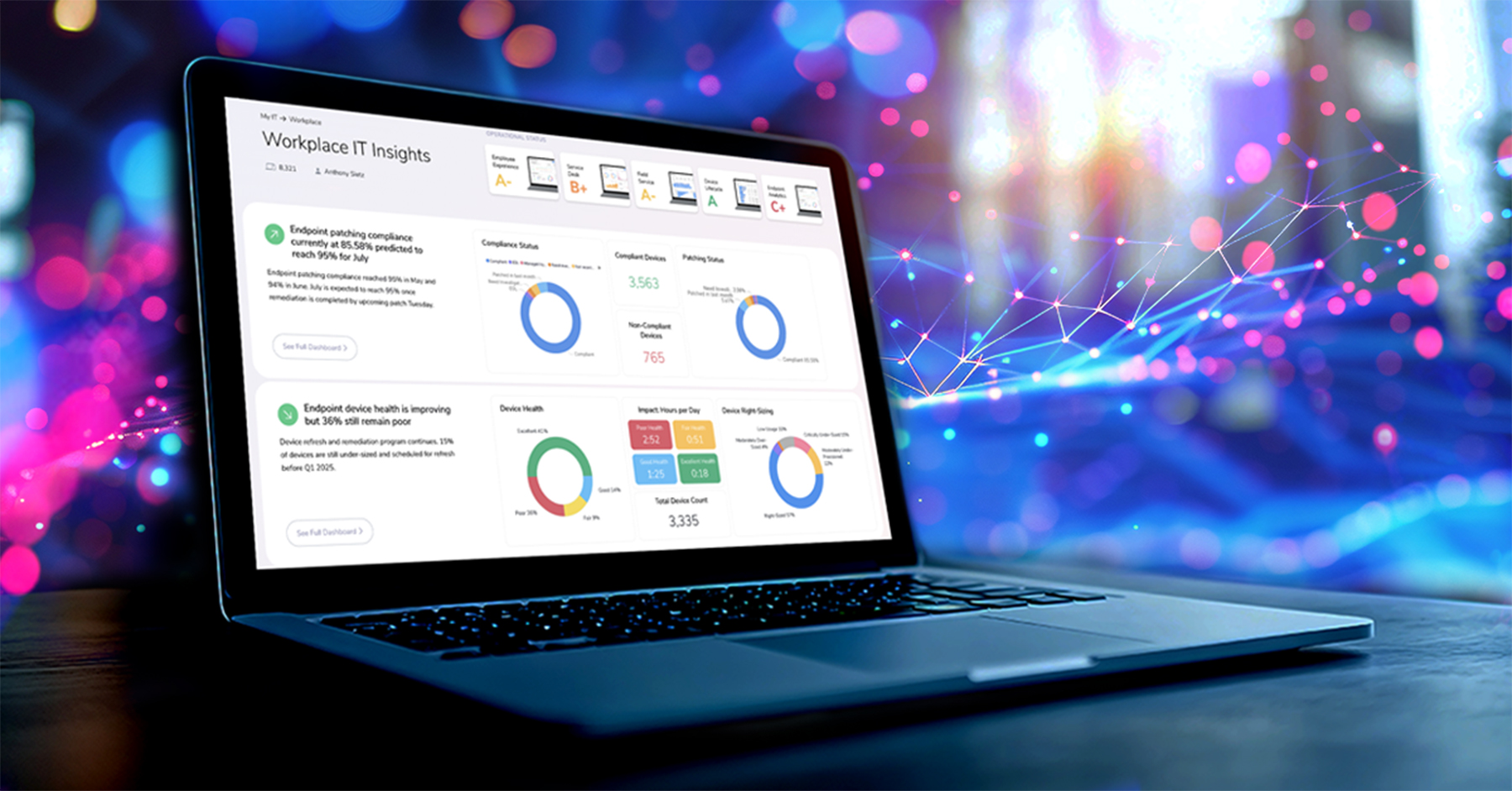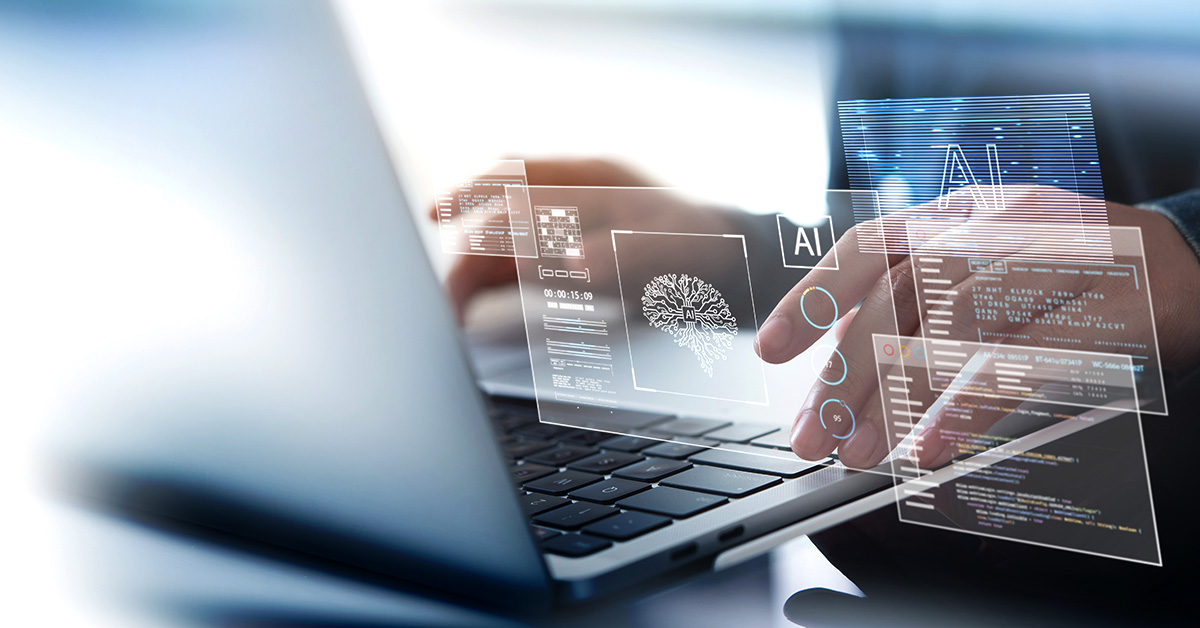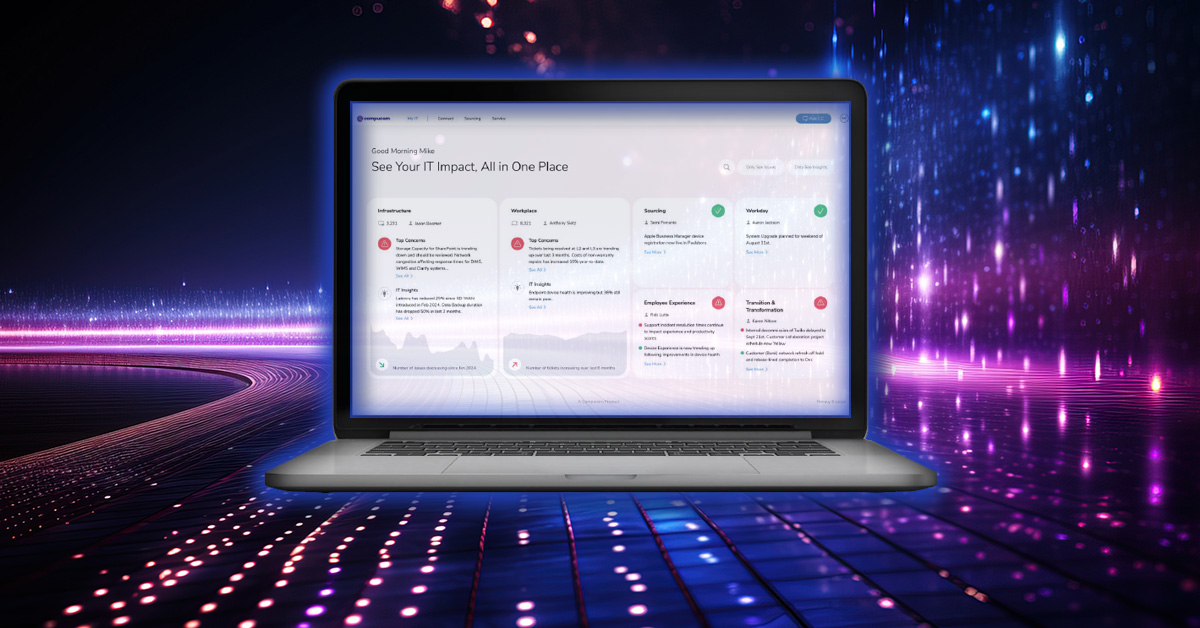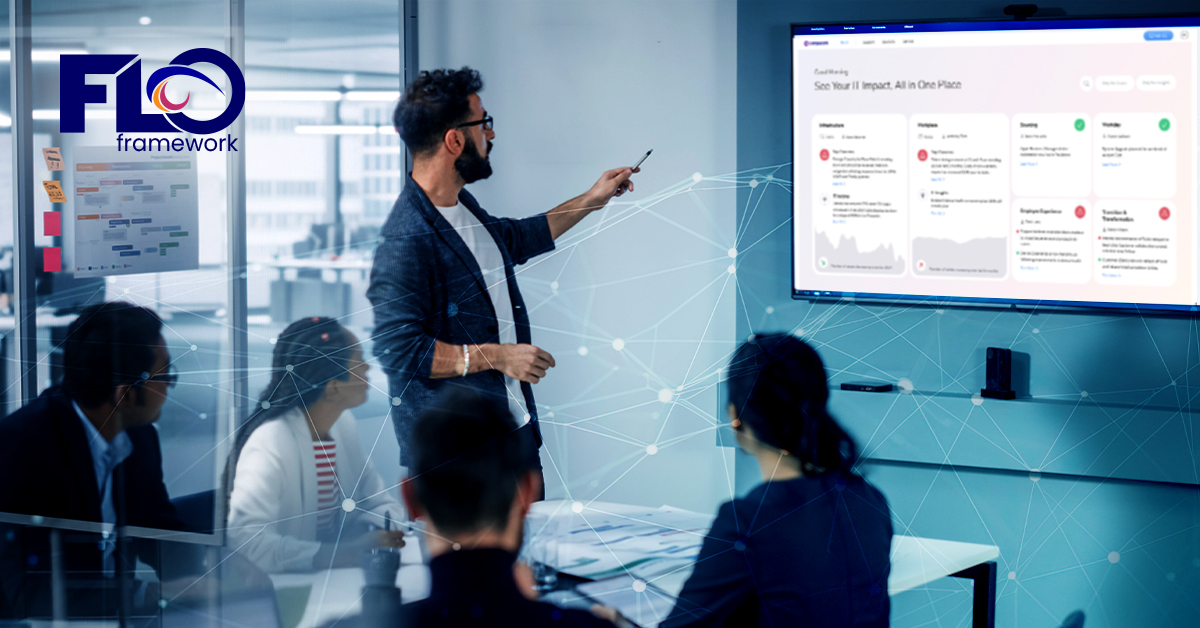- Managed Services and IT Support
- DEX


David Krauthamer • Staff Writer
DEX: Productivity, Access, and Continuous Improvement
In our previous blog, we introduced the four dimensions of Digital Experience Management (XM) that Compucom has identified and how effective management through data gathering and analytics can help to create the ideal hybrid workplace for your employees. They are:
- Technology-enabled
- Workplace Flexibility
- Self-Sufficient
- Well-Supported
These four dimensions can be divided into two main categories: technology-based and support-based. Let’s begin by looking at the two technology-based dimensions of XM: Technology-enabled and Workplace Flexibility.
Having a clear understanding of each will help us answer two very important questions about the Digital Employee Experience (DEX) in your organization:
- Can your employees work how they want, and do they have what they need to be productive?
- Can they be productive and secure, regardless of work location?
Technology: Enabling the Experience
Technology is a catalyst of innovation; it has brought some of the greatest advancements in human history. And technology is what all companies and their employees depend on each and every day to get work done. Technology is a great enabler.
But users need to feel comfortable with the technology their employer provides. Thankfully the technology landscape has evolved to a point where organizations can often provide more device choices to their workers. This allows users to access the devices, data, and services that best fit their work style and needs while allowing them to easily and securely integrate personal technology when needed.
This is what it means to be Technology-enabled. And managing this dimension means understanding and learning from the insights gathered from employees’ experiences with their applications, devices, virtual machines, and connectivity.
“It’s about having access to everything that they need to be effective and productive, whether that’s the right type of endpoint device, the appropriate security, or the needed applications.”
Trevor Kemp, Compucom’s Director of Modern Device Management
Technology: Driving Workplace Flexibility
The sudden shift to remote work brought on by the pandemic gave employees a taste of the work-life balance they’ve always wanted. Companies must take this into account, providing what their employees want or risk losing them to a company that will.
Whether your organization has a hybrid, flexible, fully remote, or mixed workplace model, you must ensure your employees have easy and secure access to the technology and services necessary to be productive. Basically, make workplace flexibility easy for the employee while securing your company’s assets and data – making sure that the highest level of security is always maintained and that it does not affect the productivity and collaboration capabilities of your workforce.
As part of the Technology-enabled dimension of Digital Experience Management (XM), we work to answer questions like:
- Do users have access to the same digital tools and peripherals at home or in the office?
- Do users have access to the data they need (via cloud or VPN) to do their jobs no matter where they are?
Analysis of these and other key experience indicators allows us to drive consistency and relevant service improvements across our managed services, ultimately resulting in a better user experience regardless of location.
“While Workplace Flexibility was already important before the pandemic, it’s become even more imperative now. It’s our job to ensure that users have the same experience no matter where they’re working – in the office, at home, or on the road.”
Troy Baldwin, Compucom’s Director of Digital Experience Management
End User and Digital Experience Come First
Enabling your employees with the right technology to be productive and ensuring they are able to work from any location are critical factors in their digital employee experience. Like any other key business initiative, effective measurement, analysis, and management are necessary to achieve the results you are looking for.
At Compucom, the digital employee experience is central to everything we do. All of our solutions and services are designed and implemented with an end-user-first mindset. Any data we can gather and analyze creates opportunities for continuous service improvements (CSI), resulting in a better overall experience, increased productivity, and happy employees who want to come to work every day and do their best.
In our next post, we’ll look at the remaining two of the Four Dimensions of Digital Experience Management – the support-based dimensions of XM: ensuring workers are Self-Sufficient and Well-Supported.
The Digital Experience Series:
RecenT

9 Ways Strategic IT Staffing Empowers Organizations

Case Studies: Asset Intelligence and Endpoint Compliance Made Easy

AI and the Enterprise: The Future of IT Management

Exploring the Opportunities and Obstacles of AI in the Enterprise

One Dashboard to Rule Them All: Strategic IT Excellence with Full Lifecycle Observability

Transforming IT Operations with Full Lifecycle Observability: How Compucom’s FLO Framework Redefines Data-Driven Efficiency
TOPICS
Digital Employee Experience: The Role of Technology
- Managed Services and IT Support
- DEX

David Krauthamer • Staff Writer
DEX: Productivity, Access, and Continuous Improvement
In our previous blog, we introduced the four dimensions of Digital Experience Management (XM) that Compucom has identified and how effective management through data gathering and analytics can help to create the ideal hybrid workplace for your employees. They are:
- Technology-enabled
- Workplace Flexibility
- Self-Sufficient
- Well-Supported
These four dimensions can be divided into two main categories: technology-based and support-based. Let’s begin by looking at the two technology-based dimensions of XM: Technology-enabled and Workplace Flexibility.
Having a clear understanding of each will help us answer two very important questions about the Digital Employee Experience (DEX) in your organization:
- Can your employees work how they want, and do they have what they need to be productive?
- Can they be productive and secure, regardless of work location?
Technology: Enabling the Experience
Technology is a catalyst of innovation; it has brought some of the greatest advancements in human history. And technology is what all companies and their employees depend on each and every day to get work done. Technology is a great enabler.
But users need to feel comfortable with the technology their employer provides. Thankfully the technology landscape has evolved to a point where organizations can often provide more device choices to their workers. This allows users to access the devices, data, and services that best fit their work style and needs while allowing them to easily and securely integrate personal technology when needed.
This is what it means to be Technology-enabled. And managing this dimension means understanding and learning from the insights gathered from employees’ experiences with their applications, devices, virtual machines, and connectivity.
“It’s about having access to everything that they need to be effective and productive, whether that’s the right type of endpoint device, the appropriate security, or the needed applications.”
Trevor Kemp, Compucom’s Director of Modern Device Management
Technology: Driving Workplace Flexibility
The sudden shift to remote work brought on by the pandemic gave employees a taste of the work-life balance they’ve always wanted. Companies must take this into account, providing what their employees want or risk losing them to a company that will.
Whether your organization has a hybrid, flexible, fully remote, or mixed workplace model, you must ensure your employees have easy and secure access to the technology and services necessary to be productive. Basically, make workplace flexibility easy for the employee while securing your company’s assets and data – making sure that the highest level of security is always maintained and that it does not affect the productivity and collaboration capabilities of your workforce.
As part of the Technology-enabled dimension of Digital Experience Management (XM), we work to answer questions like:
- Do users have access to the same digital tools and peripherals at home or in the office?
- Do users have access to the data they need (via cloud or VPN) to do their jobs no matter where they are?
Analysis of these and other key experience indicators allows us to drive consistency and relevant service improvements across our managed services, ultimately resulting in a better user experience regardless of location.
“While Workplace Flexibility was already important before the pandemic, it’s become even more imperative now. It’s our job to ensure that users have the same experience no matter where they’re working – in the office, at home, or on the road.”
Troy Baldwin, Compucom’s Director of Digital Experience Management
End User and Digital Experience Come First
Enabling your employees with the right technology to be productive and ensuring they are able to work from any location are critical factors in their digital employee experience. Like any other key business initiative, effective measurement, analysis, and management are necessary to achieve the results you are looking for.
At Compucom, the digital employee experience is central to everything we do. All of our solutions and services are designed and implemented with an end-user-first mindset. Any data we can gather and analyze creates opportunities for continuous service improvements (CSI), resulting in a better overall experience, increased productivity, and happy employees who want to come to work every day and do their best.
In our next post, we’ll look at the remaining two of the Four Dimensions of Digital Experience Management – the support-based dimensions of XM: ensuring workers are Self-Sufficient and Well-Supported.
The Digital Experience Series:
Recent Blogs

9 Ways Strategic IT Staffing Empowers Organizations

Case Studies: Asset Intelligence and Endpoint Compliance Made Easy

AI and the Enterprise: The Future of IT Management

Exploring the Opportunities and Obstacles of AI in the Enterprise

One Dashboard to Rule Them All: Strategic IT Excellence with Full Lifecycle Observability




